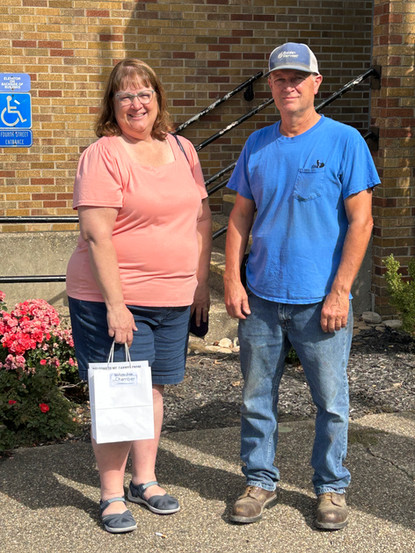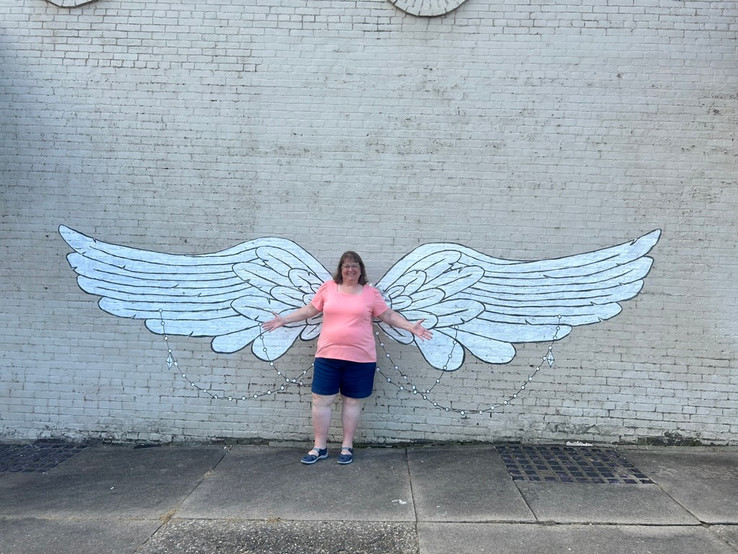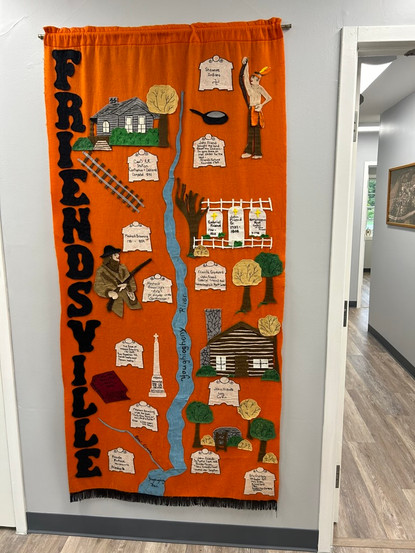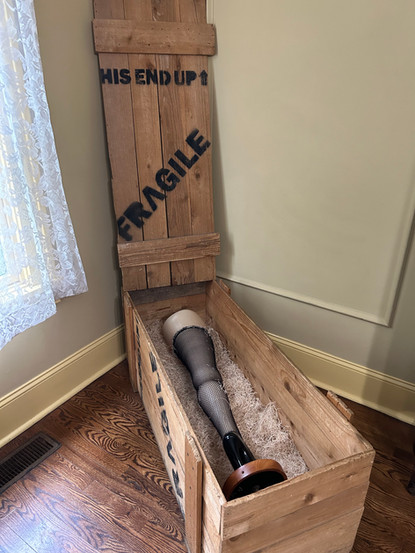Our Road Trip to the Real Friendsvilles
- Heather McDorman & Jodi Blake

- Oct 12, 2023
- 15 min read
Updated: Jan 22, 2024

Happy one year anniversary to our blog – as of tomorrow, Oct. 13, that is! We didn’t want to let this milestone pass without doing something big, something quirky, something fun. Can you say ROAD TRIP?! Fun, yes, but how did we make it big and quirky? We set out on a pilgrimage to each and every community and town named Friendsville (props – Jodi’s brainchild).
It turns out that there are six states with a town or community named Friendsville. Crazy, right? Fortunately, the towns are all in the eastern U.S. – which made the trip seem doable from our homes in the Midwest.
As a refresher, we came up with the name of our blog, Friendsville Square, because we (along with five other women) have been friends for more than 35 years following our graduations from Truman State University (formerly Northeast Missouri State University) in Kirksville, Mo. We simply put “Friends” and “ville” together and added Square to our blog moniker to create a “destination” for our readers – Friendsville Square.
Road Trip Itinerary
Using the Roadtripper app made it so easy to plan our itinerary and other details. Once we input the six Friendsville destinations, we could play around with several logistical parameters – such as how many hours we could drive in a day while timing our arrival in each town during business hours. We could also determine towns for booking hotel rooms, when we would need to depart each morning, and how much extra time we would have for some extra sightseeing.
The timing of our visits in each Friendsville was important because we wanted to meet with a town or county leader who would tell us more about their community and be willing to take a couple photos with us. (Evidence that we had really visited, you know!) We researched officials in advance, and Heather made calls to town halls, county clerks, and other government offices to arrange for a brief meet-up. We didn’t get responses from all the Friendsvilles, but we also had some unexpected – and very welcoming – encounters with residents along the way.
Let us introduce you to each of the Friendsville communities from our pilgrimage.
Friendsville, Ill. (near Mt. Carmel)
Photo 1: Friendsville is an unincorporated community in Wabash County, Ill., but it also includes a Friendsville Road. / Photo 2: Jodi represented Friendsville Square when we met up with Wabash County President of the Board of Commissioners, Timothy Hocking. / Photo 3: Across the street from the Wabash County Courthouse, Jodi found her wings.
The closest Friendsville from our St. Louis starting point was the community area just outside the town of Mt. Carmel. In this town of 6,662 close to the eastern border with Indiana, we found a thriving downtown area and signs of community spirit, including round signs attached to lamp posts for high school members of the Golden Aces marching band and color guard.
We were excited to meet our first elected official: Timothy Hocking, the chairman of the Wabash Board of County Commissioners. He’s a farmer who took a break in the middle of corn and soybean harvest to meet us at the county courthouse that morning. His family has been in the county since 1900 and farming since 1981. Timothy has been a farmer for 45 years.
While we were talking about the agriculture and coal strip mining industries in the county and soon-to-be R3 solar farms, two members of the Wabash County Chamber of Commerce walked by and shared with us a few tidbits about commerce in the county.
After receiving directions from Timothy, we drove a short way outside of town to a crossroads that marks the area known as Friendsville. Timothy wasn’t sure about the history of this area, however. The best we could capture about our first Friendsville was the road signs at the crossroads, which proves we were on Friendsville Road.
Friendsville, Tenn.
Photo 1: This historical sign provides the origins of the settling of the town of Friendsville, Tenn. / Photo 2: Though it was closed when we arrived, Friendsville, Tenn., we got a close-up look at their quaint city hall. / Photo 3: A quick selfie was called for next to the city seal. / Photo 4: The traditional looking post office is just across the street from city hall. / Photo 5: This engraved welcome sign – in the form of a giant rock – sits in the middle of town.
Feeling chuffed with our first road trip stop and meet-and-greet, we set off across part of Indiana and into Tennessee in the hopes of reaching our second Friendsville before the city hall building closed. Jodi accepted the challenge to get us there before the estimated arrival time, but we missed closing time by an hour or so.
Despite Heather calling the office a couple weeks earlier, no one had contacted us. We still hoped to meet up with someone. Unfortunately, it was not to be. After finding this quaint town, population 917, not far from Knoxville, we soon realized we arrived after business hours. Although disappointed, we still had enough daylight to capture some photos of the town, including a small park area next to the city hall.
After some online research, we learned that Friendsville was settled in the 1790s by Quakers (officially known as the Religious Society of Friends) from North Carolina. Although we didn’t see it, there is still a Friends Meetinghouse in the town. After a group of British Quakers traveled through in 1854 on a campaign promoting the abolitionist cause, Friendsville became a stop along the Underground Railroad. The residents used a cave, now filled in, near the Meetinghouse as a safe place to store provisions for enslaved people escaping the South and later for soldiers on their way to join the Union Army during the Civil War.
Friendsville, Md.
Photo 1: The council room in the town hall features a lovely banner that depicts the long history of Friendsville, Md. / Photo 2: Mayor Spencer Schlosnagle was so generous with his time as he shared the town history, took us on a tour of the town, and led us through the Friendsville Historical Museum (shoutout to Wanda Guard, administrative assistant, clerk-treasurer). / Photo 3: An historical quilt, commemorating Friendsville's 250th anniversary in 2015, is hung in the hallway of the town hall. / Photo 4: The town, situated in a valley with mountains surrounding it, features the beautiful Bear Creek that leads to the Youghiogheny River. / Photo 5: The Unique Milling Company grist mill (no longer operational) was used by farmers to grind grain, especially for buckwheat flour and cornmeal. / Photo 6: The Friend Family Association of America Heritage Museum sits at the corner of Maple Street and Second Avenue.
If the second Friendsville stop was a bit disappointing, we hit the jackpot when we visited Friendsville, Md. This town of 435 is nestled in a peaceful valley along the Youghiogheny River in the skinny western sliver of the state.
First inhabited by Native Americans, the area was later explored by John Friend, who was granted permission from the Shawnee in 1763 to return with his family and build a cabin. He originally named the location Friend’s Fortune. By the mid 1800s, Friendsville had become a thriving economic center that eventually attracted the railroad in 1889, followed by a strong logging industry until 1912, and then coal mining. Later in the 1980s, kayakers and guides from Pennsylvania and West Virginia discovered the river, the area grew into a commercial whitewater rafting mecca. Today, Friendsville’s industries include the manufacture of inflatable rafts for the military and tourism with its proximity to nature and many outdoor activities, including hiking along the Kendall Trail, biking, whitewater kayaking and rafting, boating, and fishing.
After driving through some of the town’s streets, we ended up at the town hall for a meeting with Mayor Spencer Schlosnagle, who is passionate about this town and its history. He’s a lifelong resident and has been mayor since 1986. We also met Wanda Guard, administrative assistant and clerk-treasurer, who shares a similar enthusiasm for Friendsville. She even included our visit in the town’s October newsletter. They both live up to the town’s reputation as the “friendliest little town in Maryland.”
After showing us around the town hall with its large photos of historic buildings for the town’s 250th anniversary in 2015, he gave us a tour of some of the town’s highlights, including Bear Creek, the old grist mill and the community park, and then he opened the Friend Family Association Museum that showcases historic artifacts and records from the community. You can view a virtual tour of oral histories and history tour markers.
Friendsville, Penn.
Photo 1: The street signs paid homage to the small community’s name. / Photo 2: The rolling hills in this part of Pennsylvania made for some lovely landscapes. / Photo 3: Jodi made herself at home at the Friendsville, Penn., Post Office.
Relying on GPS is a must on road trips these days, but it also helps to have a very specific destination to enter in the navigation app. It proved challenging, however, as we tried to find our fourth Friendsville, a small borough in Susquehanna County in the upper northeast corner of Pennsylvania. At first, we found ourselves driving up into the mountains on some narrow, winding roads and then onto dirt roads that did not lead us to our destination.
We tried refining our GPS search and eventually found ourselves in a small cluster of homes surrounding a Catholic church along a mountain road. We pulled into the church parking lot to consider our next move, when Jodi noticed a man standing on the porch of a house just beyond the parking lot. Heather offered to walk over to talk with him, being just a bit leery of his large dog that came running and barking across the yard. Fortunately, the man said the dog was friendly, and so was he … and his wife, who joined the conversation after a few minutes.
More knowledgeable about the town’s history, she shared that the town was originally a stagecoach stop on the Wilkes Barre Oswego Turnpike and that the Catholic parish is one of the oldest in the Scranton diocese. In earlier days, the town had nail-making and blacksmithing businesses. The couple explained that the town used to have many more houses, and it’s common to hit stone walls and find buried artifacts whenever they dig in the ground.
Before heading out of town, we drove around a couple streets to stop at the post office and then the Friendsville cemetery.
Friendsville, Ohio (near Lodi)
Photo 1: There was an absence of a welcome sign in Friendsville, Ohio, but we spied the Friendsville Cemetery sign during our travels through town. / Photo 2: We were not beyond stopping along the side of busy roads to photograph a simple street sign!
Now starting to head back toward the west, we found ourselves in Ohio near Lodi where the unincorporated community of Friendsville is located. Although Heather spoke with an assistant to the Medina County Clerk and he suggested contacting the Medina County Board of Commissioners, we did not hear back from her in time. Not deterred, we trusted our GPS to get us to our fifth Friendsville.
Again, we found a cluster of houses around a busy county crossroads. One of the roads was clearly marked as Friendsville Road, and we had also driven by the Friendsville Cemetery. So, we knew we were in the right area. There were no businesses or a post office, however, and we didn’t see anyone outside their houses who might be able to give us some information.
From some online research, we learned that the origin of the community’s name comes from the many early Quaker settlers. Before the Friendsville name, the area had been called Winston Corners after Joseph S. Winston, the original owner of the town site.
Friendsville, Mich. (near Covert)
Photo 1: We were sad to miss our opportunity to visit the Covert Historical Museum by a few weeks. Friendsville, Mich., is a part of Covert Township in Van Buren County. / Photo 2: The Covert Library historical marker sign gave us a glimpse into the rich and interesting history of Covert Township.
Our last Friendsville proved to be the most mysterious. Although we found online references to the community, when we arrived at the destination our GPS took us to, there was no evidence of a community or road bearing that name. We then ventured into the nearby town of Covert to try to talk to someone at the town hall.
Unfortunately, the town hall was closed that Friday afternoon so the asphalt parking lot could be seal coated before winter. We were also unlucky that the Covert Historical Museum closed for the season a week before we were there, except by arranged appointment – which we did not think to do ahead of time.
Next, we tried going to the Van Buren County Museum in Hartford, but it was also closed due to some exterior construction work. As a last resort, Heather called the Van Buren County Clerk’s office, but the woman she spoke to had not heard of Friendsville.
So, we thought our final stop was going to be a complete failure. As we left the area, Jodi proposed calling the Covert Historical Museum after we were home. If any place would know about Friendsville, the museum workers would. After leaving a voicemail message, Jodi was thrilled to receive a call the next day from a museum volunteer who knew about Friendsville.
It’s a community area along the same County Road 378 on which she lives. In the late 1940/1950s, there was a general store called The Friends Store. She and her four older brothers often went to the store because the owners showed cartoon movies outside. The store property was eventually sold, and the His Place Cathedral of Faith is now built on the site. The volunteer, who asked not to be named, is checking with a friend whose husband had researched the history of Friendsville. So, watch this space for an update to this post!
On a side note, the history of Covert is also very interesting – something we stumbled upon when we were trying to find clues about Friendsville. From the 1860s when the town was founded, Covert was an integrated community of black and white citizens who peacefully attended school, worshipped, conducted business and were buried in the same cemetery together. Starting in 1868, black residents were elected to government offices. For more information, you can read A Stronger Kinship: One Town’s Extraordinary Story of Hope and Faith by Anna-Lisa Cox. The Covert Historical Museum has also shared artifacts with the Smithsonian’s National Museum of African American History & Culture.
Sightseeing Along the Way
Thanks to the Road Tripper app, it was easy to map out some non-Friendsville sights to add some interest to our travels. The app allows us to identify a host of sights from which to choose by inputting a radius around our route.
We took quite a few side trips, but we have chosen to share our top six – in reverse order of our faves (mind you, each was a worthy stop):
6. Indiana Dunes National Park – Near the end of our trip we drove through northwest Indiana near the shoreline of Lake Michigan. Neither of us had been to Indiana Dunes National Park or Indiana Dunes State Park (located next to each other), so it was an easy decision to add it to our list of places to go.
Due to time constraints, we took in only a very small part of the vast Indiana Dunes National and State Parks.
The Indiana Dunes are made up of more than 15,000 acres of dunes, oak savannas, swamps, bogs, marshes, prairies, rivers, and forests. It includes 15 miles of Lake Michigan shoreline and beaches, hiking trails and forest. We were running short of time during this stop, so we took in a video, museum and gift shop at the visitor’s center and then drove through a portion of this massive park and finally got out and walked around for a bit near one of the many beaches. It’s easy to see that it is a nature enthusiast’s and hiker’s dream national park. It’s worth the visit!
5. Rock & Roll Hall of Fame – When you drive through Cleveland, you must check out the Rock & Roll Hall of Fame, right? The impressive pyramid and huge, red-lettered title entrance makes it easy to find next to the shore of Lake Erie. The museum is currently celebrating the 50th anniversary of hip hop music with an extensive exhibit. Several themed floors included guitars galore, costumes, and meaningful memorabilia of decades of rock and roll favorites.
Photo 1: You can't miss the entrance to the Rock & Roll Hall of Fame with these gigantic red letters out front! / Photo 2: The 50th anniversary of hip hop music was a featured exhibit at the Rock & Roll Hall of Fame. / Photo 3: One of the most artistic floors of the Rock & Roll Hall of Fame included unique art celebrating the music of Pink Floyd. / Photo 4: There are many famous costumes worn by artists inducted into the Rock & Roll Hall of Fame – this one belonged to Michael Jackson.
We hit most of the floors, including a funky and memorable art display commemorating Pink Floyd, had a bite to eat in the café and even voted for musicians for next year’s hall of fame class.
4. St. Joseph North Pier Inner Lighthouse – Who doesn’t love a good lighthouse? St. Joseph, Michigan, is home to the North Pier Inner Lighthouse, offering illumination to boaters in Lake Michigan. We walked out on a beautiful beach to take photos of the lighthouse (Jodi even dipped her fingers in the frigid Lake Michigan water).
Photo 1: The North Pier Inner and Outer Lights are lighthouses that sit along the shore of Lake Michigan in the quaint town of St. Joseph, Mich./ Photo 2: Jodi couldn’t resist dipping her fingers in Lake Michigan during our visit to the North Pier Inner and Outer Lights in St. Joseph, Mich. / Photo 3: Jodi met a lake gull -- let's call him Mitch -- near the water's edge. / Photo 4: We enjoyed a little time lunching and shopping in the picturesque town of St. Joseph. / Photo 5: A lovely painted mural adds extra charm to the downtown area of St. Joseph.
The lighthouse is an historic landmark and tourist attraction with two lighthouses on a breakwater. It has an elevated catwalk that stretches on for a nice walk. We didn’t take the tour, but we spent time perusing the charming town of St. Joseph and its quaint shops and restaurants.
3. Dolly Parton Statue and Sevierville – At the end of our first night of travel, right at dusk, we landed in the town center of Sevierville, Tennessee. We made it our goal to see the Dolly Parton statue (she’s a hero to us both). It’s situated so beautifully on the grounds of the courthouse surrounded by darling boutiques and charming eateries.
Photo 1: The Dolly Parton statue in the hometown of her youth, Sevierville, Tenn., looked charming as the day approached dusk. / Photo 2: The town square in Sevierville features an old fashioned courthouse.
The town is a bedroom community of the Smoky Mountains near Knoxville. We both agreed that Sevierville offered a nice mix of typical tourist attractions (but not tacky) and restaurants and lodging that would make for a satisfying girls’ weekend.
2. A Christmas Story House & Museum – "I triple dog dare you!” We couldn’t resist taking in A Christmas Story House & Museum while in Cleveland – it was only 10 minutes away from the Rock & Roll Hall of Fame.
Photo 1: This house in an old Cleveland, Ohio, neighborhood, was Ralphie’s family home and used for much of the exterior and interior filming. / Photo 2: A Christmas Story House tour would not be complete without taking note of the “fabulous” leg lamp in its “fragile” packing crate. / Photo 3: The leg lamp takes its stately position in the front window. / Photo 4: The desk in Ralphie's room with his school theme about what he wants for Christmas, the Red Ryder BB gun, and the teacher's C+ grade and cautionary comment that repeats through the movie. / Photo 5: Heather poses with Ralphie's Red Ryder BB gun with a compass in the stock and "this thing that tells time." / Photo 6: A Christmas Story tour includes a stop in the museum where several of the movie costumes were on display (Randy’s snow suit is a favorite!).
Our tour guide was a true fan of the movie, and you could tell that as he spewed out fact after fact about the movie, the actors, the house, and the props of the Christmas classic. The house we toured was used for most exterior shots and many of the interior filming, as well. It was decorated to match the movie as closely as possible, including the famous leg lamp! The museum is home to iconic outfits of Ralphie, Randy and other cast members; several Red Rider BB Guns; and so much more. This stop is a must-see for fans of the movie. If you are a huge fan, you can book a night at Ralphie’s neighbors, the Bumpeses.
1. Fallingwater – By far and away, our classiest and most Zen sight-seeing stops was Fallingwater, a home designed by acclaimed architect Frank Llyod Wright. Wright was famous for incorporating nature into his designs, and this home and surrounding property was a shining example of that.
Photo 1: The entrance sign is in keeping with the natural setting of Fallingwater. / Photo 2: The Fallingwater property is nestled in the lush Bear Run Nature Reserve, but informative signage leads you there. / Photo 3: One of the many views a visitor will take in of the Fallingwater house. / Photo 4: A side view of Fallingwater offers another perspective of its unique Frank Lloyd Wright architecture. The steps lead down to the water at the top of the waterfall, over which the house is built. / Photo 5: Interior living space features couches cantilevered from the walls to mirror the house's exterior and other furnishings designed by the Frank Lloyd Wright. / Photo 6: Fallingwater and the woods surrounding the house make for a lovely backdrop for Jodi.
Fallingwater was designed in 1935 for the Kaufmann family, owners of Pittsburgh's largest department store. The home is nestled in Bear Run, Pennsylvania, and features a waterfall on the edge of the property. Fallingwater is a composition of various materials, including stone, concrete, steel, glass, and wood. Its structural system includes a series of reinforced concrete cantilevered balconies. The building is supported by these concrete beams that jut out from the main structure and appear to float above the waterfall.
It’s something you must see for yourself to truly appreciate it. Put Fallingwater on your list if you travel to northeastern U.S. It is a construction marvel situated in a peaceful and stunning setting.
Our Road Trip by the Numbers
We love capturing fun stats, so here’s a quick overview of our road trip.

Ready to Hit the Road, Too?
What kind of quest would you like to undertake in your travels … visit all the baseball stadiums, all the towns you grew up in, all the amusement parks? Or how about selecting another town name and planning a road trip like we did? Maybe all towns in the U.S. named Madison (27), Paris (22), or Springfield (34) – admittedly, you’d need more than one road trip or a month of traveling time for any of these options. Let us know your road trip plans or dreams in the comments below.



































































































I'm just dropping in to let you know I added your beautiful wings to my FB group called WINGED WALLS WORLDWIDE. I find and log wings from all over. I've collected almost 1400 sets of wings!! I track them in the group and on a google map for others to easily find. https://www.facebook.com/groups/762490879167943/
This is SUPER!! What a cool idea and execution of that idea. And now I know about (and have downloaded!) the Roadtrippers app, too!
What an awesome way to mark one year of Friendsville Square! Really enjoyed reading about your adventures.